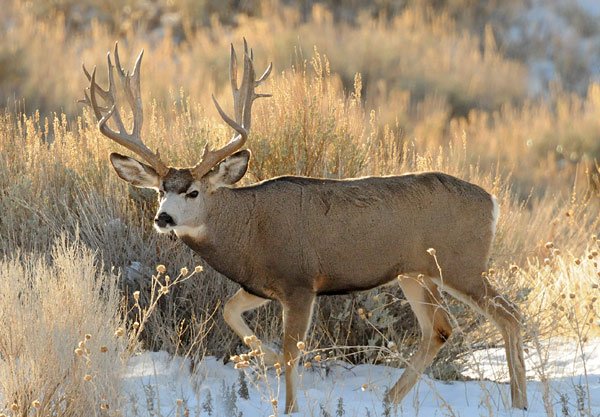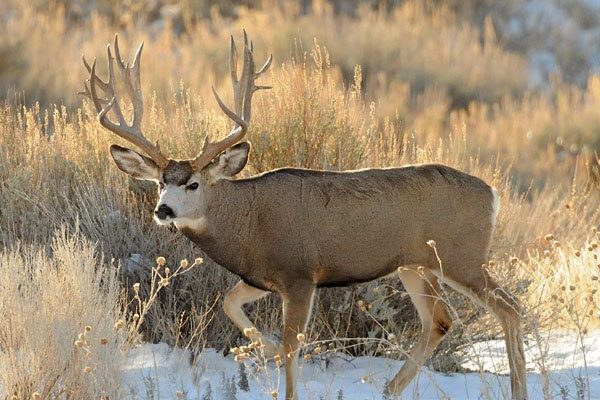
These deer differ in many ways from their white-tailed cousins, boasting a set of traits that make them both interesting and easy to recognize. If you’ve ever seen a mule deer, you might have noticed their large ears, which resemble those of a mule—hence the name. If you’re curious about these creatures and want to learn more, let’s jump right into ten fascinating facts that will leave you with a deeper appreciation for mule deer.
1. Distinctive Ears: The Name Says It All
When you first spot a mule deer, you can’t help but notice their large, mule-like ears. These ears are not just for show; they serve a vital purpose. Mule deer have excellent hearing, which helps them detect predators from afar. Imagine having oversized headphones that amplify sound—these deer can pick up faint noises that might escape other animals!
Their keen sense of hearing pairs well with their remarkable vision. Mule deer can see more colors than humans, allowing them to spot changes in their environment easily. This combination of sharp senses is crucial for survival in the wild, where dangers lurk around every corner.
For many people, the ears are a delightful feature that sets mule deer apart. While they might remind you of a cartoon character, these ears are serious business when it comes to staying safe in their natural habitats.
2. The Antlers: A Unique Growth Cycle
Mule deer are well-known for their impressive antlers, which are quite different from those of other deer species. Every year, male mule deer grow a new set of antlers, a process that starts in the spring. As summer approaches, these antlers become more prominent, often branching out in a distinctive forked shape.
Did you know that antlers are made of bone? Yes! They’re not just fluffy decorations. They are shed every winter, allowing the deer to conserve energy during the harsh months. This process of shedding and regrowing can be compared to a tree losing its leaves in autumn—it’s a natural part of their growth cycle. When spring arrives, they begin to grow again, covered in a soft skin called velvet that eventually falls away as the antlers harden.
This unique cycle of growth is vital for males, as they use their antlers in battles for mates and territory. Observing these majestic battles can be a breathtaking sight during the fall mating season.
3. Habitat and Distribution: Wide-Ranging Wanderers
Mule deer are incredibly adaptable creatures, found across diverse landscapes—from mountainous regions to open plains. Their range stretches from Canada all the way down to Mexico, showcasing their resilience in various habitats. This adaptability is a key reason why they thrive in different environments, and it also makes them a favorite among wildlife enthusiasts and photographers alike.
These deer prefer areas with plenty of cover, such as forests, brushy areas, and grasslands. They can often be spotted in rural and suburban settings too—an exciting encounter for those living in these areas! It’s not unusual to see them grazing near roads or in fields, always on the lookout for food while keeping an eye out for potential predators.
Their wide-ranging nature allows them to migrate to different areas as seasons change, moving to lower elevations during winter and higher ones in summer. This seasonal movement not only helps with feeding but also provides some protection from predators.
4. Diet and Foraging: Nature’s Grazers
Mule deer are herbivores, primarily feasting on leaves, shrubs, grasses, and tree bark. They have a specialized digestive system that allows them to break down tough plant materials efficiently. When you watch them munching away, you might notice how selective they can be about what they eat—like a picky eater at a buffet!
These deer often browse on plants available in their environment, adapting their diet based on the season. In spring and summer, they enjoy fresh greens and tender buds, while in fall and winter, they might rely on more fibrous materials like twigs and bark. Think of them as nature’s gardeners, playing a role in maintaining the health of their ecosystems by helping control vegetation growth.
Interestingly, mule deer can go days without drinking water, getting much of their hydration from the plants they consume. This ability to thrive in various conditions adds to their charm as resilient creatures of the wild.
5. Social Structure: A Mix of Solitary and Social Behaviors
Mule deer have an intriguing social structure that varies throughout the year. During the spring and summer months, you can often find them in small groups, usually consisting of females and their fawns. These groups provide safety in numbers, making it easier to spot predators.
However, as fall approaches and mating season begins, male mule deer tend to become more solitary. They seek out females and can often be seen wandering alone, displaying their impressive antlers. You might be wondering what happens to the females during this time. They stick together to care for their young while keeping an eye on the roaming males.
Once autumn mating season passes, these deer often regroup. It’s like a family reunion, where they come together again to forage and socialize. This flexibility in social behaviors showcases their ability to adapt based on environmental pressures and life stages.
6. Unique Defense Mechanisms: The Art of Escape
When faced with danger, mule deer have several fascinating defense strategies. Their most famous escape tactic is their remarkable ability to jump. They can leap up to 10 feet high and cover distances of about 30 feet in a single bound. It’s like watching a skilled athlete in action!
But here’s the thing: jumping isn’t their only approach to saving themselves. Mule deer can also use their agility and speed to zigzag away from predators, making it harder for them to be tracked. Think of them as tricky dance partners in a game of survival, constantly changing direction and keeping their foes guessing.
Their coat color also plays a role in their defense. During the summer, their fur blends beautifully with the environment, helping them stay hidden from potential threats. In winter, their fur becomes thicker and grayer, providing camouflage against the snowy backdrop. This natural adaptability is just one more reason to admire these creatures.
7. Breeding and Fawn Care: The Next Generation
The breeding season for mule deer, also known as the rut, takes place in the fall. During this time, males engage in a series of impressive displays to attract females. You might see them sparring with their antlers or showcasing their strength and stamina to win a mate. It’s nature’s version of a reality dating show!
Once a male successfully mates with a female, the female carries the fawns for about 200 days. During this period, she focuses on finding safe, secluded spots to give birth—often choosing places with plenty of cover to protect her young. Once the fawns are born, they’ll remain hidden for the first few weeks, relying on their mother to provide food.
When it’s time to venture out, the fawns can follow their mother within just a few days, quickly adapting to life in the wild. It’s incredible to watch the bond between mother and fawn, with the mother teaching her young how to forage for food and navigate their surroundings. This nurturing behavior ensures the next generation of mule deer thrives.
8. Conservation Status: Challenges Ahead
While mule deer are generally abundant, they still face several threats that can impact their population. Habitat loss due to urban development, agriculture, and climate change poses significant challenges. Think about how our growing cities often push wildlife into smaller and smaller areas—mule deer are no exception.
Additionally, hunting regulations play a role in their conservation. Responsible hunting practices can help maintain healthy populations, but overhunting can lead to declines. Several organizations are actively working to protect these beautiful creatures and their habitats, raising awareness of the importance of conservation.
Efforts to restore habitats and create wildlife corridors are essential to ensure mule deer can continue to thrive alongside human development. It’s a team effort that requires both wildlife enthusiasts and everyday people to help make a difference.
9. Mule Deer vs. White-Tailed Deer: What’s the Difference?
A common question among wildlife lovers is how to tell mule deer apart from white-tailed deer. While both species share similarities, some distinct features set them apart. For starters, mule deer have larger ears that resemble a mule, while white-tailed deer sport a more slender appearance.
Another key difference is their tails. Mule deer have a black-tipped tail that they raise while running, while white-tailed deer flash their white underbellies as a warning sign to other deer. Their antlers also have different shapes—mule deer antlers tend to fork, while white-tailed deer antlers grow in a more typical branching pattern.
When it comes to behavior, mule deer are more likely to stay on the ground rather than climb trees, preferring to navigate through their natural habitats. Both species have unique adaptations, but recognizing these differences can enhance your appreciation for them.
10. Fascinating Fables: Cultural Significance of Mule Deer
Mule deer have played an essential role in the cultures and folklore of Native American tribes. They symbolize strength, endurance, and adaptability, often appearing in stories and art. For many tribes, mule deer are not just animals but sacred beings that teach lessons about respect for nature and the interconnectedness of life.
In modern times, mule deer continue to inspire wildlife enthusiasts, photographers, and conservationists alike. They remind us of the beauty of the wilderness and the importance of preserving our natural heritage. When you see a mule deer, take a moment to appreciate its significance in both nature and human culture.
Mule deer are more than just another pretty face in the animal kingdom; they embody resilience, adaptability, and the spirit of nature. From their distinctive ears to their impressive antlers, every aspect of their lives contributes to the harmony of their ecosystems. By learning about these fascinating creatures, we gain insight into the delicate balance of nature and our role in protecting it.
So, the next time you spot a mule deer grazing peacefully, remember the incredible facts we’ve explored together. Whether you’re a wildlife enthusiast or simply someone who enjoys the beauty of nature, mule deer are a reminder of the magic that surrounds us every day. Let’s celebrate and protect these magnificent animals for generations to come!

